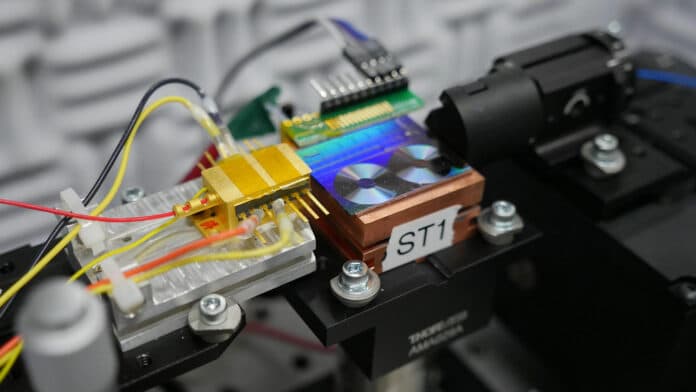Researchers at the National Institute of Standards and Technology (NIST) have developed a compact time-keeping chip that can convert light into microwaves, which could significantly impact various technologies such as GPS, phone and internet connections, radar and sensing systems, and more.
This advancement could lead to a significant improvement in the precision and accuracy of these technologies that rely heavily on timing and communication.
The technology can improve the stability and precision of microwave signals by reducing timing jitter to a very small fraction of a second – 15 femtoseconds, to be exact. This could lead to an increase in radar sensitivity, better accuracy for analog-to-digital converters, and clearer astronomical images captured by telescope groups.
What makes this demonstration unique is the compact design of its components that produce the signals. For the first time, researchers have managed to shrink much of what was once a tabletop-size system into a compact chip similar in size to a digital camera memory card. The reduction in timing jitter on a smaller scale not only decreases power usage but also makes it more practical for everyday devices.
At the moment, some of the technology’s components are situated outside the chip while their effectiveness is being tested. However, the ultimate objective of this project is to combine all the different parts, including lasers, detectors, modulators, and optical amplifiers, onto a single chip.
By integrating every component onto a single chip, the team could decrease both the system’s size and power consumption. This means that it can be effortlessly incorporated into small devices without requiring excessive energy or specialized training.
“The current technology takes several labs and many Ph.D.s to make microwave signals happen,” said Frank Quinlan, NIST physical scientist. “A lot of what this research is about is how we utilize the advantages of optical signals by shrinking the size of components and making everything more accessible.”
Researchers rely on a semiconductor laser to achieve their goals. This laser serves as a dependable flashlight that is directed into a small mirror container called a reference cavity. The reference cavity is akin to a miniature room in which the light bounces around. Certain light frequencies inside the cavity match the size of the container, causing the peaks and valleys of the light waves to fit perfectly between the walls.
The result is that the light builds up power at those frequencies, which is utilized to maintain the laser’s frequency stability. The stable light is then transformed into microwaves by a frequency comb, which changes high-frequency light into lower-pitched microwave signals. These exact microwaves are critical to technologies like communication networks, navigation systems, and radar because they provide precise timing and synchronization.
“The goal is to make all these parts work together effectively on a single platform, which would greatly reduce the loss of signals and remove the need for extra technology,” said Quinlan. “Phase one of this project was to show that all these individual pieces work together. Phase two is putting them together on the chip.”
In navigation systems such as GPS, the precise timing of signals is essential for determining location. In communication networks, such as mobile phone and internet systems, accurate timing and synchronization of multiple signals ensure that data is transmitted and received correctly.
For example, synchronizing signals is important for busy cell networks to handle multiple phone calls. This precise alignment of signals in time enables the cell network to organize and manage the transmission and reception of data from multiple devices, like your cellphone. This ensures that multiple phone calls can be carried over the network simultaneously without experiencing significant delays or drops.
In radar, which is used for detecting objects like airplanes and weather patterns, precise timing is crucial for accurately measuring how long signals bounce back.
“There are all sorts of applications for this technology. For instance, astronomers who are imaging distant astronomical objects, like black holes, need really low-noise signals and clock synchronization,” said Quinlan. “And this project helps get those low noise signals out of the lab and into the hands of radar technicians, of astronomers, of environmental scientists, of all these different fields, to increase their sensitivity and ability to measure new things.”
Journal reference:
- Igor Kudelin, Franklyn Quinlan, Scott A. Diddams, et al. Photonic chip-based low-noise microwave oscillator. Nature, 2024; DOI: 10.1038/s41586-024-07058-z
